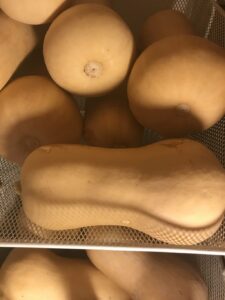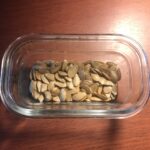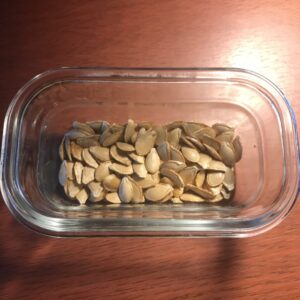- Like
- Digg
- Del
- Tumblr
- VKontakte
- Buffer
- Love This
- Odnoklassniki
- Meneame
- Blogger
- Amazon
- Yahoo Mail
- Gmail
- AOL
- Newsvine
- HackerNews
- Evernote
- MySpace
- Mail.ru
- Viadeo
- Line
- Comments
- Yummly
- SMS
- Viber
- Telegram
- Subscribe
- Skype
- Facebook Messenger
- Kakao
- LiveJournal
- Yammer
- Edgar
- Fintel
- Mix
- Instapaper
- Copy Link

A version of this column first ran in the Roane County (WV) Reporter and Times Record as part of a gardening series. Support local journalism! Subscribe to your local newspaper. This is one of a series of blogs for new gardeners. Start reading the whole series here: Part 1.
Last week I talked about ways to use potatoes, an excellent storage crop. This week we’ll get into a couple of other good keepers—sweet potatoes and winter squash. I don’t think these are closely related—one’s a fruit and the other a root crop, or tubers to be precise—but both are cucurbits, vine plants. They both keep well at room temperature in dry, dark places (they might keep a little better at somewhat cooler temperatures, if you can arrange that). And both are usually orange which probably means they’re high in carotene, vitamin A. Both are sweet—and yet sweet potatoes are okay for diabetics, while regular potatoes are not.
The most obvious and easiest way to cook both items is to roast them. For sweet potatoes, just poke them with a fork to let steam escape and put them in a pan in the oven. Don’t just put them directly on an oven rack, as they sometimes exude a sweet liquid…which is easier to clean from a pan than from your oven. (Ha. Like I really ever clean my oven. Do you clean yours? But actually, stuff like sweet potato drips building up on the floor of the oven can smoke, so I do clean that off.)
Several sources say winter squash tastes better if baked than boiled; you put it cut side down in the pan (yes, of course you cleaned out the seeds first), and maybe add a little bit of water but that’s not crucial. I like to throw some butternut or sweet potato in my oven when I’m running it anyway for something else (or regular potatoes, it’s also handy to have pre-baked potatoes around for omelets or at worst, chicken feed). When the baked, softened squash comes out of the oven, let it cool, then clean out the pulp with a spoon and compost the empty peels. The cooked squash will keep in the fridge for most of a week, or in your freezer practically forever. As for the seeds, some  people eat them—they’re rich in protein and supposed to aid prostate health—but I find the plastic-like hulls too much, so I give them to my chickens. But our photographer does roast, salt and eat the seeds.) There are hulless varieties of pumpkins but I’ve tried them two or three times and never gotten a significant crop.
people eat them—they’re rich in protein and supposed to aid prostate health—but I find the plastic-like hulls too much, so I give them to my chickens. But our photographer does roast, salt and eat the seeds.) There are hulless varieties of pumpkins but I’ve tried them two or three times and never gotten a significant crop.
Either sweet potato or squash are fine just served hot with some butter. Some people like to add marshmallows and sweetener to sweet potatoes but I regard that as bringing coal to Newcastle–or West Virginia—they’re sweet enough. Squash is, of course, the basis for “pumpkin” pie—I’ll assume you have a recipe for that. But you can also use sweet potatoes for pie. Mostly I’m thinking here about butternut squash but any winter squash will do for pie; however you might need to adjust the recipe. I have grown cushaws, big squash which are not as sweet as butternuts and don’t keep quite as long, but are more resistant to powdery mildew which often hits squash in September, and just as resistant to borers. I have a recipe for cushaw pie which works well (thanks to Jan Mertz); drop a note in the comment section below, and I’ll send it along to you. The other thing about cushaws is that they’re a different species from butternuts, so you can save seed from both. I plan to grow a lot of squash next year; I think I’ll do at least one hill of cushaws.
I have a recipe also for a quite different use of butternuts, a parmesan much like lasagna. You peel and slice the squash a quarter inch thick and put it in layers with a cheese filling and tomato sauce. Request that recipe in the comment section below.
Then there are quick breads that use baking powder and/or baking soda instead of yeast—sweet breads. These recipes are easy to find.
With orange sweet potatoes, I like them fried—I don’t make French fries but my husband sometimes does, and he tried using sweet potatoes once. I thought they were good, though different from the regular kind. But what I do is add minced sweet potato to the diced potatoes for breakfast home fries.
When I was a vegetarian, I would sometime stuff a winter squash and bake it instead of something like turkey.
Butternut can make excellent soup; coconut milk goes well in such recipes. I also have a recipe for a peanut soup, which came from a column in this paper some years ago, which calls for diced sweet potato. Both are delicious and not so easy to find, so again—send make a request in the comment section below if you want the recipe.
Read the rest: Part 1. Part 2. Part 3. Part 4. Part 5. Part 6. Part 7. Part 8. Part 9. Part 10. Part 11. Part 12. Part 13. Part 14. Part 15. Part 16. Part 17. Part 18. Part 19. Part 20. Part 21. Part 22. Part 23. Part 24. Part 25. Part 26. Part 27. Part 28. Part 29. Part 30. Part 31. Part 32. Part 33. Part 34.













